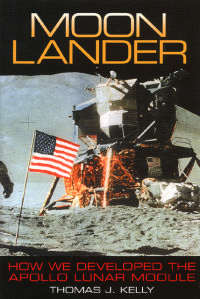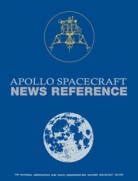 Thomas Kelly was the project engineer for the Apollo Lunar Module, built by Grumman Aircraft at their Bethpage, New York, “Ironworks” between 1962 and 1970. Grumman developed and built fifteen LMs, six of which landed on the Moon. The craft is unique – the only manned spacecraft designed to land on an airless satellite, and the only manned spacecraft ever to have done so.
Thomas Kelly was the project engineer for the Apollo Lunar Module, built by Grumman Aircraft at their Bethpage, New York, “Ironworks” between 1962 and 1970. Grumman developed and built fifteen LMs, six of which landed on the Moon. The craft is unique – the only manned spacecraft designed to land on an airless satellite, and the only manned spacecraft ever to have done so.
Moon Lander opens in 1960, as Kelly describes the feasibility study for landing on the Moon which Grumman put together in an effort to get involved in building spacecraft. At that time, the company was best-known its naval aircraft, and in fact its largest customer was the US Navy. But NASA was likely to spend billions of dollars in the coming decades, and Grumman felt space engineering was an excellent future prospect.
opens in 1960, as Kelly describes the feasibility study for landing on the Moon which Grumman put together in an effort to get involved in building spacecraft. At that time, the company was best-known its naval aircraft, and in fact its largest customer was the US Navy. But NASA was likely to spend billions of dollars in the coming decades, and Grumman felt space engineering was an excellent future prospect.
And then in May 1961, President John F Kennedy gave his speech to Congress, declaring that the US “should commit itself to achieving the goal, before this decade is out, of landing a man on the Moon and returning him safely to the Earth”. The Apollo programme moved into high gear, and Grumman’s earlier feasibility study made them an excellent candidate for involvement. But first, of course, they had to put together a bid and win the contract. Which they did.
Designing and building the LM presented a number of problems, many of which seemed on occasion would prevent the craft from ever being completed. Chief among these was weight. As the LM programme progressed, the weight of the craft kept on climbing, and a severe weight reduction programme was required – inspired by the SWIP (Super Weight Improvement Program) performed by Grumman on the US Navy General Dynamics/Grumman F-111B (which was subsequently cancelled). The LM SWIP succeeded, although it involved a number of trade-offs: for example, the gauge of wiring used throughout the LM was reduced, which both saved weight but also made the wiring prone to breakages.
The nature of the LM’s mission meant it had to be the most reliable craft ever built. If anything in it failed, it would strand the two astronauts on the Moon. And yet the limited weight meant Grumman could not simply build in multiple back-ups or fail-over equipment. Instead Grumman chose to simplify as much of the LM’s workings as possible, and to test everything thoroughly to ensure it would never fail. This last was not always successful. When Grumman tested LM-1’s propulsion and reaction control systems for leaks, it passed. But when NASA ran their own tests at KSC, the craft failed – so much so that the NASA engineers described it as a “piece of junk that leaked like a sieve”.
Perhaps because I’ve read a number of books about the Apollo programme, and none previously specifically about the LM, but I found Moon Lander a much more interesting read than some of the books I’ve reviewed on this blog. But then I find the hardware – and the challenges it was designed to overcome – more fascinating than I do the personalities involved. Moon Lander
a much more interesting read than some of the books I’ve reviewed on this blog. But then I find the hardware – and the challenges it was designed to overcome – more fascinating than I do the personalities involved. Moon Lander may not be, as prose, as enjoyable a read as Michael Collins’ excellent autobiography Carrying the Fire
may not be, as prose, as enjoyable a read as Michael Collins’ excellent autobiography Carrying the Fire (see here), but it had the benefit of covering a subject, with a great deal of detail, not found in other works on Apollo. Moon Lander
(see here), but it had the benefit of covering a subject, with a great deal of detail, not found in other works on Apollo. Moon Lander does exactly what its subtitle claims, and it does it from the perspective of someone who was very much involved. There are perhaps no great insights into what the Apollo programme, or its achievements, meant, but the book certainly provides plenty of fascinating information on the process of designing and building the Lunar Module.
does exactly what its subtitle claims, and it does it from the perspective of someone who was very much involved. There are perhaps no great insights into what the Apollo programme, or its achievements, meant, but the book certainly provides plenty of fascinating information on the process of designing and building the Lunar Module.
Perhaps because he was an engineer, and not an astronaut (all of whom had larger-than-life egos), Kelly does not use his book as a platform to inflate his own importance. When he gets it wrong, he’s happy to admit so. He’s equally fair when handing out praise and acknowledging the contributions of others. It’s a pleasant surprise to read a book about Apollo in which the author’s personality doesn’t threaten to overwhelm the events being described.
Moon Lander ‘s prose is serviceable at best and clumsy at worst, which is not unexpected – Kelly was an engineer, not a writer. He tries to avoid writing too much like an engineer, although not entirely successfully: “The next morning the delicious tingle of anticipation hung over KSC like the morning sea haze through which the fiery orange Sun groped its ways to the ground” (pg 193).
‘s prose is serviceable at best and clumsy at worst, which is not unexpected – Kelly was an engineer, not a writer. He tries to avoid writing too much like an engineer, although not entirely successfully: “The next morning the delicious tingle of anticipation hung over KSC like the morning sea haze through which the fiery orange Sun groped its ways to the ground” (pg 193).
Despite a shaky start, the Grumman LM was later acknowledged to be one of the most reliable pieces of hardware used by the Apollo programme. It was designed to meet a unique challenge, and it did so admirably. The LM is an historically important machine, and it’s good that its history has been chronicled so throughly by one of the people instrumental in its development and construction. Moon Lander belongs in the collection of anyone interested in the Apollo programme.
belongs in the collection of anyone interested in the Apollo programme.
Moon Lander , Thomas J Kelly (2001, Smithsonian Institution Press, ISBN 1-56098-998-X, 266pp + notes and index)
, Thomas J Kelly (2001, Smithsonian Institution Press, ISBN 1-56098-998-X, 266pp + notes and index)


